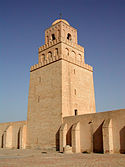Mohammed al-Tawudi ibn Suda
Mohammed al-Tawudi ibn Suda | |
|---|---|
| Personal life | |
| Born | 1700 |
| Died | 1795 |
| Main interest(s) | Islamic jurisprudence, Hadith, Sufism |
| Notable work(s) | Commentary on Sahih al-Bukhari |
| Alma mater | Al-Azhar University |
| Occupation | Scholar, Mufti, Shaykh al-Jamaa |
| Religious life | |
| Religion | Islam |
| Denomination | Sunni |
| Creed | Maliki |
| Senior posting | |
Influenced by | |
Influenced | |
| Moroccan literature |
|---|
| Moroccan writers |
| Forms |
| Criticism and awards |
| See also |
Mohammed ibn al-Talib al-Tawudi ibn Suda (Arabic: محمد التاودي بن سودة; 1700–1795) was one of the most influential scholars of the 18th century in Morocco, both politically and intellectually. He is described by the Egyptian historian, Al-Jabarti, as the "crescent of the Maghrib".[1] He went on the hajj in 1767-1768 and studied in Medina with Mohammed ibn Abdel Karim al-Samman (1718–1775), founder of the Sammaniyya branch[2] of the Khalwatiyya and in Cairo with the Indian scholar Mohammed Murtada al-Zabidi (d. 1791). In Cairo he also taught the Muwatta of Malik ibn Anas at the Al-Azhar. Ibn Suda was appointed by the sultan in 1788 to reform the curriculum at the Qarawiyin University of Fez, where he was installed as mufti and shaykh al-jamaa. Ibn Suda is also well known as the author of a commentary on Sahih al-Bukhari[3] and as the teacher of Ahmed ibn Idris.
See also
References
- ^ Rex S. O'Fahey, Enigmatic saint: Ahmad ibn Idris and the Idrisi tradition, London, 1990, p. 35-36
- ^ it:Sammaniyya
- ^ See: Abd al-Hayy ibn Abd al-Kabir al-Kattani, Fihris al-faharis wa'l-athbat wa-mu'jam al-ma'ajim wa'l-mashyakhat wa'l-musalsalat, ed. Ihsan Abbas, 3 vols., Beirut 1982-6, pp. 256-63,

